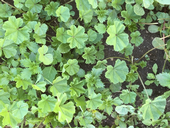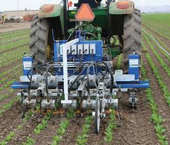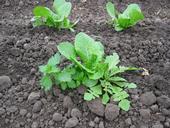- Author: Richard Smith
- Posted by: Gale Perez

Automated lettuce thinners that use a spray mechanism to remove unwanted lettuce plants and weeds have been widely adopted in the Salinas Valley and desert production districts. The machines utilize a camera to capture images of the lettuce plants in the seedline, calculate plants that need to be removed and those that will be kept (keepers) and then it activates a spray mechanism treat the unwanted plants. The spray mechanism has advantages over mechanical devices (e.g. swinging or spinning blades) because they do not disturb the soil or cut roots, and in addition, they have less inertia and can be quicker in responding to a signal from the computer. However, spray mechanisms can potentially drift or wafting control materials onto the...
- Author: Richard Smith
- Posted by: Gale Perez
The following information is from the Salinas Valley Agriculture blog.
On January 12, 2016 the Federal EPA label for Kerb SC was reinstated for leaf lettuce. The registration on leaf lettuce was pulled in 2009 and Dow AgroSciences has been working to reregister Kerb since that time. As part of this reregistration effort, Kerb was reclassified as “not likely to be carcinogenic to humans” which freed up space in the risk cup. Of particular interest are the preharvest intervals allowed in the label:
- Author: Richard Smith

Richard Smith, Farm Advisor and Tricia Love, Research Assistant
University of California Cooperative Extension Monterey County
SUMMARY
The current automated weeding machines use cameras to detect plants, and a computer algorithm to process the image, calculate which plants to keep/remove, and activate a kill mechanism. These machines are capable of cultivating within the seedline and removing weeds that would otherwise be left by traditional cultivation. The machines used in these studies included the Robovator, F Poulsen Engineering Aps, Hvalsø, Denmark and Steketee IC Weeder, the Netherlands. Both of these machines use a split knife that as it...
- Author: Richard Smith
- Posted by: Gale Perez

Weed control in cool-season vegetables can be quite challenging. However, there are a number of practices that provide growers with certain advantages:
- Short-season crops such as lettuce and spinach that allow for rapid turnover of the crops (e.g. 30 to 65 days), frequent cultivation (lettuce) and/or complete hand removal of weeds prior to mechanical harvest (clipped spinach and baby lettuce)
- High value of the crops allows for the use of intensive hand-removal of weeds, often prior to seed set
- Small production blocks that allow for careful observation and intensive management
All of these strategies have basically made some of the most troublesome weeds such as field bindweed and yellow...
- Author: Steven Fennimore
There are few new herbicide active ingredients in the pipeline now. In the 1970s and 1980s several new active ingredients were introduced every year. There were lots of jobs in industry and weed science was the place to be. I myself was with ICI/Zeneca from 1983 to 1994 in their R&D group. However, we are now in the middle of the second decade of the 21st century and new herbicide active ingredients might cost $300 million from discovery to launch. Needless to say there are not many new active ingredients in the pipeline. We have a few agricultural chemical companies that are screening for new active ingredients and perhaps the large scale of glyphosate resistant weed problems will stimulate some of the agricultural...


